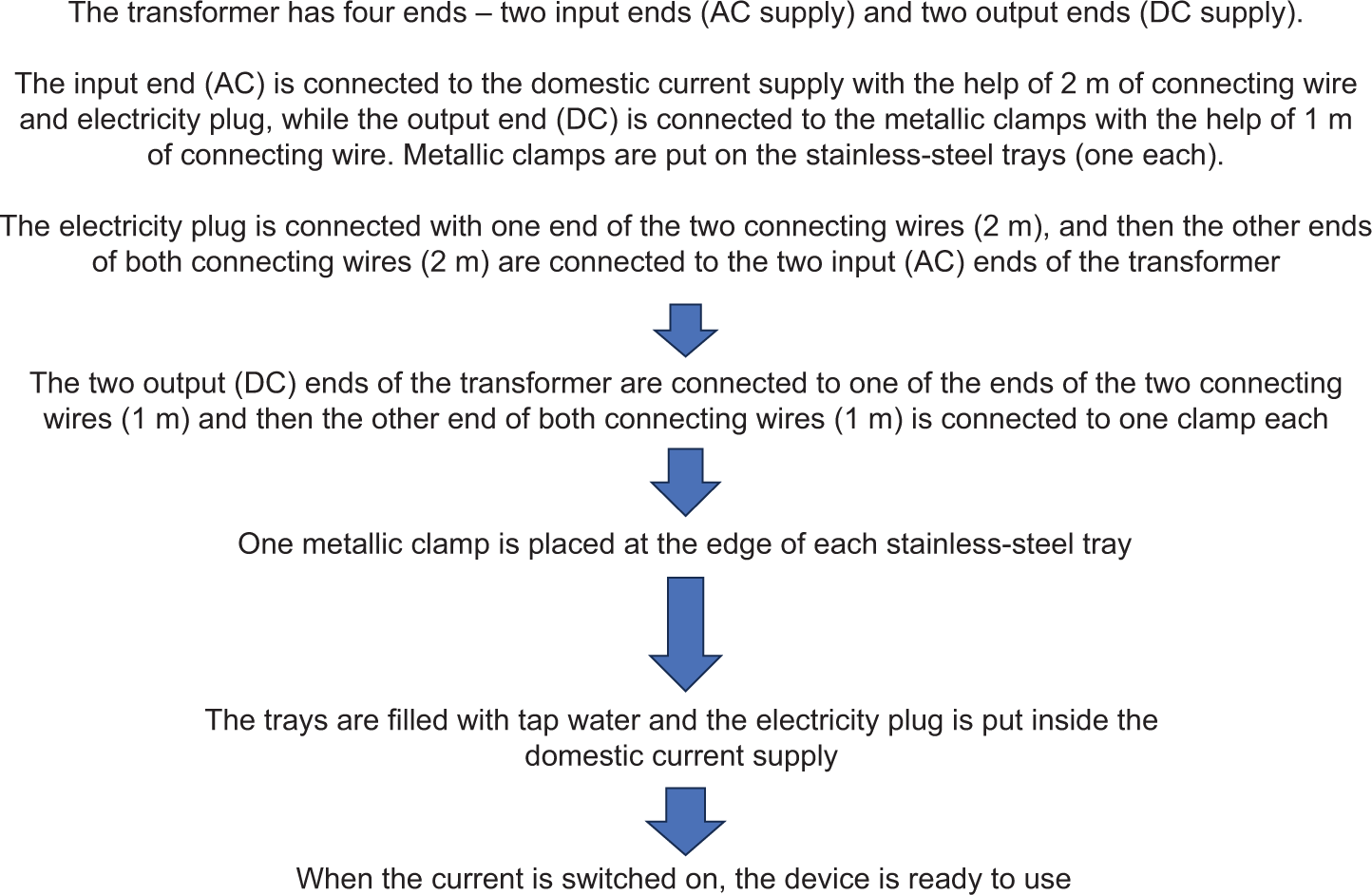Translate this page into:
Innovative Low-cost Home-made Iontophoresis Device
*Corresponding author: Vishvender Singh, Department of Dermatology and Sexually Transmitted Diseases, VMMC and Safdarjung Hospital, New Delhi, India. vsyen22@gmail.com
-
Received: ,
Accepted: ,
How to cite this article: Singh V, Srivastava P, Suresh P, Khunger N, Misri R. Innovative Low-cost Home-made Iontophoresis Device. Indian J Postgrad Dermatol. 2025;3:99-100. doi: 10.25259/IJPGD_111_2023
Palmoplantar hyperhidrosis is a chronic, socially disturbing condition, usually idiopathic in nature. Iontophoresis is a procedure in which an electrical current is passed through skin soaked in tap water, normal saline (0.9%) or a solution containing an anticholinergic medication, which allows ionised particles to cross the normal skin barrier. It reduces sweating and enhances the delivery of drugs into the skin. It is safe, effective and inexpensive.[1] Due to the high cost of the procedure, it remains underutilised in a low-income country such as India.
A 25-year-old gentleman presented with idiopathic palmoplantar hyperhidrosis of 5 years duration, which was not relieved by several topical as well as oral treatments, including oral oxybutynin. He was started on our innovative home-made iontophoresis, which gave satisfactory results within 6 weeks [Figure 1].

- Instructions to assemble the low-cost home-made iontophoresis device. AC: Alternating current, DC: Direct current.
The materials used are easily accessible at a very affordable price for poor people and those in remote areas [Table 1]. For palmar hyperhidrosis, place the stainless-steel trays on a non-conductive surface without them touching each other. Fill the trays with enough tap water to submerge the palms completely. The patient can sit on a wooden chair or stand with shoes on. Each hand is placed in a tray of water containing active and indifferent electrodes. It is recommended to apply petroleum jelly to the skin at the water line and any small cuts or wounds to prevent discomfort and localised inflammation. The device is activated, allowing current to pass through the water between the electrodes. Initially, three sessions of 15 min each are conducted on alternate days, 3 times a week for 1 month, followed by weekly maintenance sessions. This schedule is ideal for balancing effectiveness and minimising patient inconvenience. If the patient does not respond to tap water iontophoresis alone, anticholinergics like a 2 mg glycopyrrolate tablet can be added to the water tray [Figure 2].[2]

- Innovative low-cost home-made iontophoresis device. AC: Alternating current, DC: Direct current.
| S. No. | Component | Quantity | Cost (INR) |
|---|---|---|---|
| 1. | 220–12V (AC to DC) transformer | 1 | 90 |
| 2. | Thin stainless-steel tray | 2 | 200 (100 each) |
| 3. | Connecting wire | 4 (two -2 m long and two -1 m long) | 20 |
| 4. | Metallic clamps | 2 | 10 (5 each) |
| 5. | Electricity plug | 1 | 10 |
| Total cost | 330 |
AC: Alternating current, DC: Direct current, INR: Indian National Rupee
DO’S AND DON’TS
Do’s
Put the trays at a flat horizontal surface
Apply moisturiser or jelly over both hands before dipping the hands into water for the uniform spread of current
Patient must wear rubber footwears and sit comfortably on an insulated plastic chair.
Don’ts
There should not be any cuts/erosions/fissures over the hands of the patient
Patient should not be wearing any metallic ornaments over hands and fingers
Patient should not have a pacemaker.
Ethical approval
Institutional Review Board approval is not required.
Declaration of patient consent
The authors certify that they have obtained all appropriate patient consent.
Conflicts of interest
Dr. Niti Khunger is on the Editorial Board of the Journal.
Use of artificial intelligence (AI)-assisted technology for manuscript preparation
The authors confirm that there was no use of artificial intelligence (AI)-assisted technology for assisting in the writing or editing of the manuscript and no images were manipulated using AI.
Financial support and sponsorship
Nil.
References
- Manual of Dermatologic Therapeutics (8th ed). Philadelphia, PA: Lippincott Williams and Wilkins; 2014.
- [Google Scholar]
- Iontophoresis for Palmar and Plantar Hyperhidrosis. Dermatol Clin. 2014;32:491-4.
- [CrossRef] [Google Scholar]







